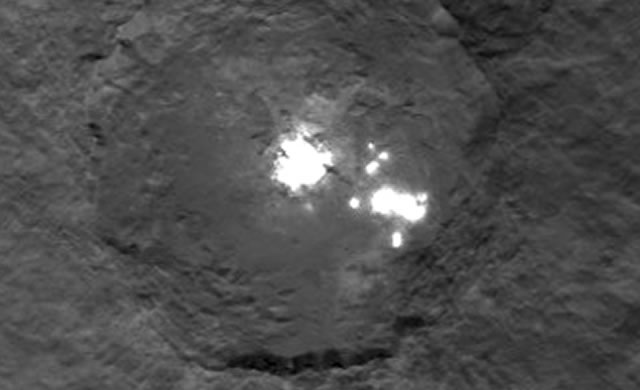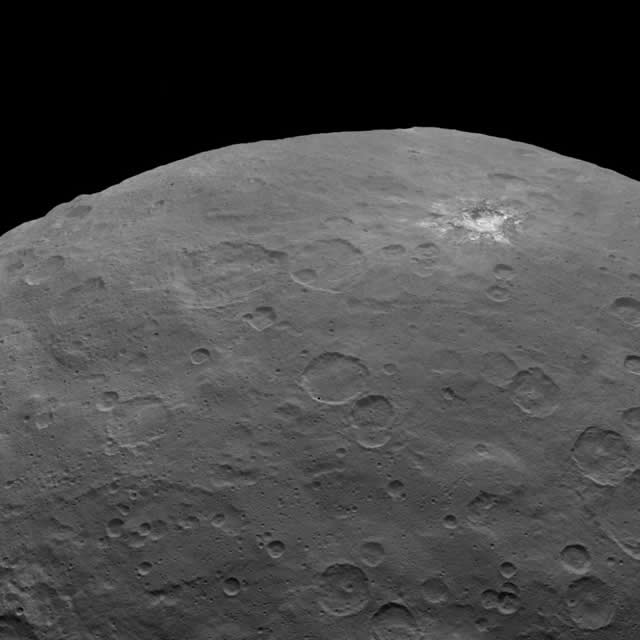
Nuove immagini del pianeta nano Cerere riprese dalla sonda Dawn della Nasa, mostrano la superficie costellata da crateri di questo mondo misterioso con dettagli mai visti prima.
Questi scatti sono stati effettuati dalla seconda orbita prevista a circa 4.400 km dalla superficie di Cerere. Le macchie più brillanti si trovano all’interno di un cratere che misura 90 km. Queste macchie brillanti sono formate da diversi punti più piccoli e diversi per dimensione, con un ammasso centrale. Gli scienziati non hanno comunque ancora trovato una spiegazione per quanto osservato dalle più recenti immagini, sia per quanto riguarda i gradi di luminosità sia per la zona in cui si trovano. Queste macchie brillanti fanno di Cerere un caso unico e mai visto prima nel sistema solare. Il team di studiosi stanno ancora lavorando per capirne la fonte. “Un riflesso dovuto alla presenza di ghiaccio resta il mio miglior candidato, ma il team tiene in considerazione anche altre possibilità, come la presenza di sale. Con la possibilità di fare osservazioni sempre più ravvicinate e da molteplici angolazioni, molto presto saremo in grado di determinare la natura di questo enigmatico fenomeno”, fa sapere Chris Russell, il principale investigatore della missione Dawn, dalla base dell’Università della California, a Los Angeles.
Ma è chiaro amici che le ipotesi riferite da Russell non escludono anche altro, così come lo stesso team della sonda Dawn fa sapere attraverso Twitter:
@NASA_Dawn: Il materiale brillante, ovunque su #Cerere, è un mistero, ma potrebbe essere sale, ghiaccio e roccia, o qualcos’altro.
— DENEB Official © (@denebofficial) 17 Giugno 2015
New images of dwarf planet Ceres, taken by NASA’s Dawn spacecraft, show the cratered surface of this mysterious world in sharper detail than ever before.
These are among the first snapshots from Dawn’s second mapping orbit, which is 2,700 miles (4,400 kilometers) above Ceres. The region with the brightest spots is in a crater about 55 miles (90 kilometers) across. The spots consist of many individual bright points of differing sizes, with a central cluster. So far, scientists have found no obvious explanation for their observed locations or brightness levels. “The bright spots in this configuration make Ceres unique from anything we’ve seen before in the solar system. The science team is working to understand their source. Reflection from ice is the leading candidate in my mind, but the team continues to consider alternate possibilities, such as salt. With closer views from the new orbit and multiple view angles, we soon will be better able to determine the nature of this enigmatic phenomenon,” said Chris Russell, principal investigator for the Dawn mission based at the University of California, Los Angeles.

Questa immagine, sempre ripresa da una distanza di 4,400 km dalla sonda Dawn, mostra altre zone di Cerere in cui si trovano diverse macchie brillanti. La foto, con una risoluzione pari a 410 m per pixel, risale al 6 giugno 2015. This image, taken by NASA’s Dawn spacecraft, shows dwarf planet Ceres from an altitude of 2,700 miles (4,400 kilometers). The image, with a resolution of 1,400 feet (410 meters) per pixel, was taken on June 6, 2015.
Source/Continue reading → Nasa.gov





















